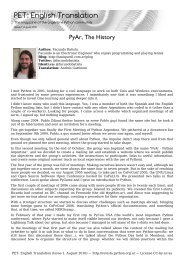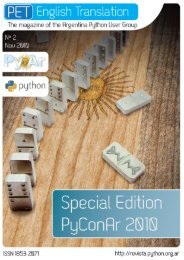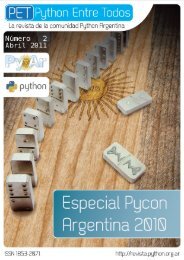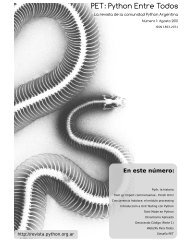A4 portrait - PET: Python Entre Todos - Python Argentina
A4 portrait - PET: Python Entre Todos - Python Argentina
A4 portrait - PET: Python Entre Todos - Python Argentina
You also want an ePaper? Increase the reach of your titles
YUMPU automatically turns print PDFs into web optimized ePapers that Google loves.
Context managers 12<br />
print "Starting to work"<br />
time.sleep(2)<br />
print "Finished working"<br />
def main():<br />
print "Starting the main program"<br />
thread = processing.Process(target=trabajador)<br />
print "Launching thread"<br />
thread.start()<br />
print "Thread has been launched"<br />
# isAlive() is False when the thread ends.<br />
while thread.isAlive():<br />
# Here you would have the code to make the app<br />
# look "alive", a progress bar, or maybe just<br />
# keep on working as usual.<br />
print "The thread is still running"<br />
# Wait a little bit, or until the thread ends,<br />
# whatever's shorter.<br />
thread.join(.3)<br />
print "Program ended"<br />
# Important: the modules should not execute code<br />
# when they are imported<br />
if __name__ == '__main__':<br />
main()<br />
Yes, the only change is import multiprocessing instead of import threading and<br />
Process instead of Thread. Now the worker function runs in a separate <strong>Python</strong><br />
interpreter. Since they are separate processes, this will use as many cores as<br />
processes you have, so it may be much faster on a modern computer.<br />
I mentioned deadlocks earlier. You may believe that with a little care, if you place<br />
locks around variables you can avoid them. Well, no. Let’s see two functions f1 and<br />
f2 which use two variables x and y protected by locks lockx and locky.<br />
# -*- coding: utf-8 -*-<br />
import threading<br />
import time<br />
x = 4<br />
y = 6<br />
lock_x = threading.Lock()<br />
lock_y = threading.Lock()<br />
def f1():<br />
lock_x.acquire()<br />
time.sleep(2)<br />
lock_y.acquire()<br />
time.sleep(2)<br />
lock_x.release()<br />
lock_y.release()<br />
def f2():<br />
lock_y.acquire()<br />
time.sleep(2)<br />
lock_x.acquire()<br />
time.sleep(2)<br />
lock_y.release()<br />
lock_x.release()<br />
def main():<br />
<strong>PET</strong>: English Translation (Issue 1, August 2010) — http://revista.python.org.ar
















